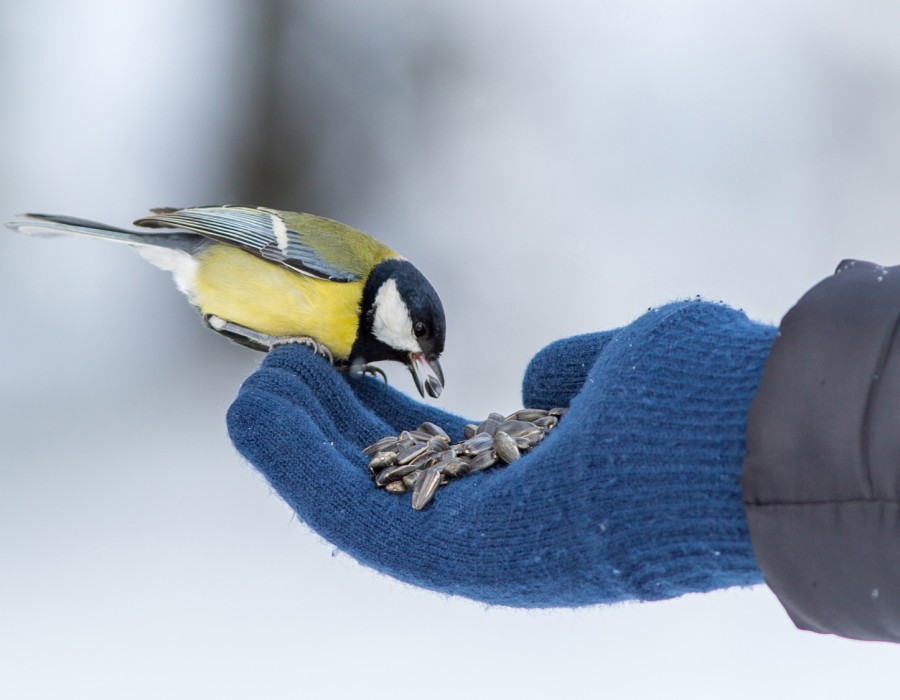Bernd Heinrich, PhD, was hiking through the woods in Maine when he happened upon a group of ravens feasting on a dead moose. They were making quite a ruckus, recalls Heinrich, a biology professor at the University of Vermont. In fact, the birds used a loud call that Heinrich had never heard before, a call that seemed to attract even more ravens to the area. Their behavior puzzled the researcher.
“Ecological theory would tell you that a food bonanza would be defended and not shared,” he says.
But the birds were sharing. Some of the ravens even returned to their roost to recruit more animals, Heinrich observed. The strange behavior inspired the biologist to conduct a series of field studies, which he eventually published in the book “Ravens in Winter” (Simon and Schuster, 1989).
Heinrich’s helpful ravens are now a classic example of animal altruism, says Jeff Stevens, PhD, a psychology professor at the Max Planck Institute for Human Development in Germany. But like most examples of animal altruism, the apparently selfless act had selfish benefits.
The sharing ravens, it turned out, were juveniles who had found the moose carcass in a mature raven’s territory. By bringing other young ravens to the feast, they avoided being chased off by the territory-holding bird. For any behavior to survive natural selection, it needs to help an animal or its genetic material, he notes.
“True altruism…paying a cost to help another individual and never ever receiving any kind of benefit, is not very common,” Stevens says. “It wouldn’t make much sense biologically for that to happen.”
Help a brother out
More commonly, when an animal assists another, there is a hidden reward for the helper, says Nigel Barber, PhD, a Maine-based psychologist and author of “Kindness in a Cruel World” (Prometheus Books, 2004). Perhaps the most widespread form of altruism, he notes, is the case of a parent protecting and feeding its young. Birds will rob themselves of nutrition to regurgitate food into the gaping maws in their nest. But even if an altruistic act endangers a parent’s own life, it makes evolutionary sense to increase the likelihood one’s young will survive, Barber notes.
“They are acting in the interest of their genes, if not their own lives,” he says.
A similar principle is at play when an animal assists its siblings or cousins, says Stevens. This is the case when worker bees devote themselves to feeding the offspring of the hive’s queen, instead of trying to reproduce themselves. The bee phenomenon puzzled Charles Darwin, and may be why he sat on his theory of natural selection for more than 20 years. The answer, proposed by biologist William Hamilton in the 1960s, is that sterile worker bees are helping to further their genes because they are so closely related to the young they are helping to raise.
“Most examples of altruism do involve kin,” Stevens says.
That’s true of humans too, notes Barber. Many studies have shown that while people do help strangers, they are more likely to give money to relatives. Additionally, adopted children, on average, get a smaller share of inheritances than biological children, according to an analysis of 1,538 California estates, published in a 1992 issue of Ethology and Sociobiology (Vol. 13, No. 5, pages 495-522).
“This may support kin selection, but I think that is probably not doing justice to the complexity of the situation,” says Barber, noting that some adopted children may enter into a family as toddlers or even teens, and subsequently may not develop as close as a relationship with their parents.
Even for bats, familiarity–as well as their genetic relatedness–seems to increase the likelihood of altruistic behavior.
Primitive insurance policies
Vampire bats have a fast metabolism and a food supply that is high in protein but low in fat. That means that they must feed on the blood of cattle or other animals every 36 hours, or they die.
So it surprised biologist Gerald Wilkinson, PhD, when he discovered, in the 1980s, that female bats would share their blood with unlucky hunters, regurgitating blood into the mouths of female roost mates.
“I had observed a lot of cases of them feeding their own young, which is how they wean their young from milk to blood, but this was the first time I had seen adults feeding other adults,” notes Wilkinson, now a program director at the National Science Foundation.
In a 1984 study, published in Nature (Vol. 308, No. 1, pages 181-184), Wilkinson reported that the animals did tend to feed closely related kin. But they also would feed “friends”–unrelated bats they roosted with. The friend would return the favor later, Wilkinson reports.
As a result of the animals’ inborn tendency to share, female bats manage to live upwards of 15 years, says Wilkinson. Stingy male bats survive about half that long.
“The adaptive rationale behind all of this is sort of an insurance policy,” says Barber. “You pay in a small amount and benefit when you need it later.”
Whether the bats are aware of their sharing policy is a matter of contention. It’s possible that they are born with a useful rule: help out familiar animals. Most of the time, that rule helps propagate their genes, as most roost mates are related, says Stevens.
In fact, pure altruism may be an accident of evolution, researchers suggest. A vampire bat that feeds an unrelated roost mate is, in effect, mistaking it for a sister. A bird that adopts another animal’s chick does so because it’s compelled to feed every hungry mouth in its nest. And raven researcher Bernd Heinrich treats his dog as part of the family because the human tendency for empathy has run amok, he says.
“It’s part of our social nature to help those that we are associated with,” says Heinrich “It’s not that we evolved to love dogs, and as a side product we love our babies. It is just the opposite.”
- Abuse & The Abuser
- Achievement
- Activity, Fitness & Sport
- Aging & Maturity
- Altruism & Kindness
- Atrocities, Racism & Inequality
- Challenges & Pitfalls
- Choices & Decisions
- Communication Skills
- Crime & Punishment
- Dangerous Situations
- Dealing with Addictions
- Debatable Issues & Moral Questions
- Determination & Achievement
- Diet & Nutrition
- Employment & Career
- Ethical dilemmas
- Experience & Adventure
- Faith, Something to Believe in
- Fears & Phobias
- Friends & Acquaintances
- Habits. Good & Bad
- Honour & Respect
- Human Nature
- Image & Uniqueness
- Immediate Family Relations
- Influence & Negotiation
- Interdependence & Independence
- Life's Big Questions
- Love, Dating & Marriage
- Manners & Etiquette
- Money & Finances
- Moods & Emotions
- Other Beneficial Approaches
- Other Relationships
- Overall health
- Passions & Strengths
- Peace & Forgiveness
- Personal Change
- Personal Development
- Politics & Governance
- Positive & Negative Attitudes
- Rights & Freedom
- Self Harm & Self Sabotage
- Sexual Preferences
- Sexual Relations
- Sins
- Thanks & Gratitude
- The Legacy We Leave
- The Search for Happiness
- Time. Past, present & Future
- Today's World, Projecting Tomorrow
- Truth & Character
- Unattractive Qualities
- Wisdom & Knowledge






Comments